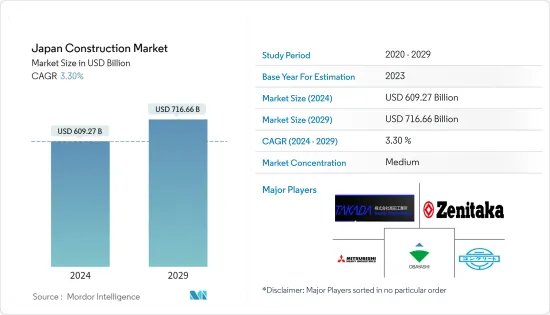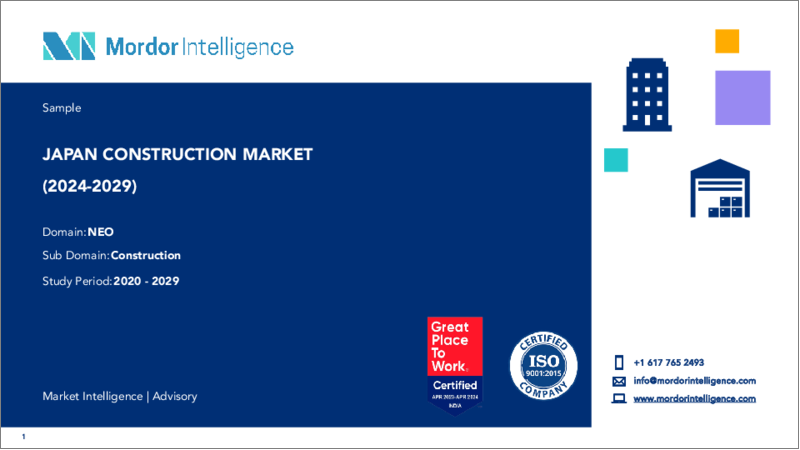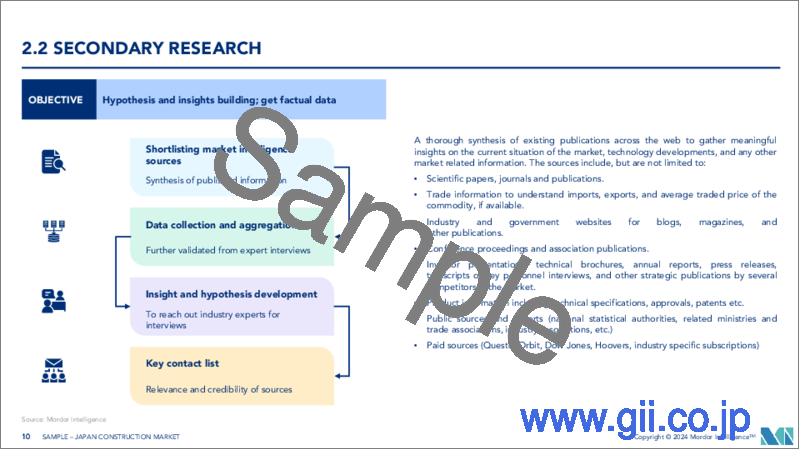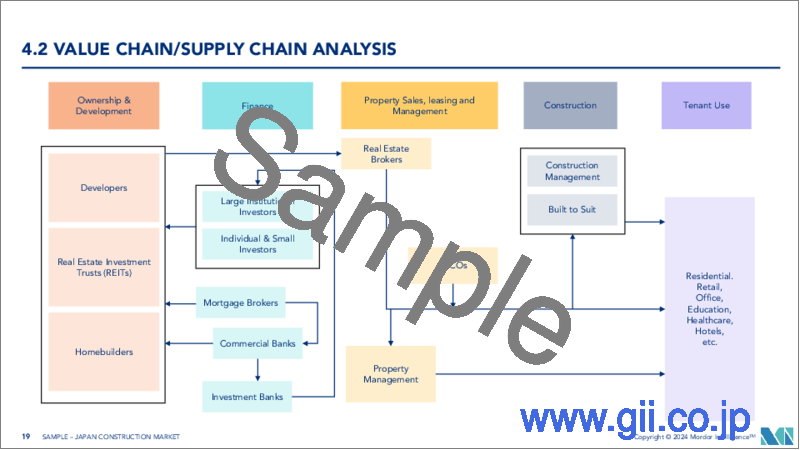|
|
市場調査レポート
商品コード
1435790
日本の建設市場:市場シェア分析、産業動向と統計、成長予測(2024年~2029年)Japan Construction - Market Share Analysis, Industry Trends & Statistics, Growth Forecasts (2024 - 2029) |
||||||
カスタマイズ可能
適宜更新あり
|
|||||||
| 日本の建設市場:市場シェア分析、産業動向と統計、成長予測(2024年~2029年) |
|
出版日: 2024年02月15日
発行: Mordor Intelligence
ページ情報: 英文 120 Pages
納期: 2~3営業日
|
全表示
- 概要
- 目次
日本の建設市場規模は2024年に6,092億7,000万米ドルと推定され、2029年までに7,166億6,000万米ドルに達すると予測されており、予測期間(2024年から2029年)中に3.30%のCAGRで成長します。

主なハイライト
- 建設業界は日本経済の重要な柱であり、2021年の国内総生産(GDP)の約5.5%を生み出しました。東日本大震災からの復興と東京オリンピックの影響で、過去10年間の業界全体の上昇傾向に貢献しています。年。日本には登録建設会社が47万社以上あるが、この業界は大林組、大成建設、鹿島建設、清水建設、タネカの大手ゼネコン5社からなるグループ、スーパーゼネコンが独占しています。年間売上高は合わせて1兆円を超え、建設、建築設計、研究開発などさまざまな業界で事業を展開しています。
- 日本の建設業界は、1990年代のバブル崩壊以来続いた低迷からここ10年で回復してきました。復興は、2011年の東日本大震災後の復興活動によってもたらされました。2021年の東京オリンピックは、近年の主要な需要喚起の役割を果たしました。リニア中央新幹線の開発や2025年大阪万博に向けて予定されているその他の建設プロジェクトも同様の効果が期待されます。
- 政府は、防災、減災、国土強靱化のための5か年加速計画の一環として約15兆円(1,200億米ドル)を投資する予定で、これにより今後数年間で建設工事の需要が高まると考えられます。
- 日本の輸出に対する国際的な強い需要と、政府が承認した過去最高額の55兆7,000億円(4,900億米ドル)の財政刺激策が、日本の建設生産を支援しています。日本政府は半導体分野に7,740億円(68億米ドル)を投資し、成長を支援し、次世代半導体の現地生産拡大を優先しています。
日本の建設市場動向
インフラ開発の増加が市場を後押し
日本の都市インフラは世界でも有数です。日本のインフラ開発戦略は多くの段階に対応しており、それぞれの段階で経済成長と持続可能性のバランスをとる重要性が強調されていました。 2022年8月、日本政府は新たな原子力発電所の建設を命令しました。注目すべきことに、新しい原子力発電所の建設と開発は、世界のエネルギー不足の中で同国がエネルギー輸入への依存を減らすのに役立つと思われます。
日本政府は、国際的なインフラ開発の取り組みにおいてインドと提携することを検討しています。両国がすでにプロジェクトに取り組んでいるネパールのような国でのインフラプロジェクトの共同計画、設計、実施は、ニューデリーと東京がその効果を最大化するのに役立つ可能性があります。インドの革新的ではなく、より手頃な価格のデジタルソリューションは、発展途上国、特に東南アジアの国々に適しています。東アフリカ、ベトナム、インドネシア、カンボジアの日本企業や政府機関にとって、インフラ整備は優先事項となっています。
中国政府は、中国の一帯一路構想によるインフラ支援を活用し、この地域での影響力を高めています。しかし、「債務の罠外交」という主張が中国のスポンサーを悩ませています。インフラは現在、この地域で増大する外交上の対立の重要な側面となっているため、4か国のQuadはインフラに関する作業部会を設立しました。
日本の住宅建設セクターの発展推進力として政府資金が活用されている
日本政府はここ数年、子育て世帯に住宅補助金を支給しています。 2022年には、この傾向はさらに強まると予想されています。国土交通省は、日本の住宅所有の経済的負担を軽減するため、住宅ローンを組む個人に対する住宅購入に対する税制上の優遇措置など、さまざまな政策を設けた上で、施策の拡充を図る方針です。
政府は2021年、新築建設に奨励金を支給することで子育て世帯の住宅購入を支援する措置を講じた。注目すべきは、政府がこの制度に対して一戸当たり60万円から100万円の範囲の奨励金を提供したことです。この取り組みは、2021年度追加予算で542億円(4億2,000万米ドル)の融資を受け、2021年11月に開始されました。
政府は2022年にこのプログラムに追加の600億円(4億6,000万米ドル)を割り当てました。政府はまた、補助金には12万件の申請が見込まれるため、期限を2022年10月末から2023年3月末まで延長しました。今後3~4年間、こうした政府の取り組みにより、日本の住宅購入者からの需要が減少し、住宅建築セクターの拡大が促進される可能性があります。
日本の建設業の概要
市場は細分化されており、国内の建設投資の増加と今後の大規模プロジェクトにより、予測期間中に成長すると予想されます。しかし、業界に対する政府支出の増加により、市場は中小企業にチャンスをもたらしています。予測期間中に、日本の建設市場は拡大する可能性があり、市場競争力が高まる可能性があります。
日本の建設市場の主要企業は、大林組、三菱重工業、日本コンクリート工業、高田建設、銭高建設、三井住友建設、東芝です。
その他の特典
- エクセル形式の市場予測(ME)シート
- 3か月のアナリストサポート
目次
第1章 イントロダクション
- 調査の前提条件
- 調査範囲
第2章 調査手法
第3章 エグゼクティブサマリー
第4章 市場力学
- 市場促進要因
- 市場抑制要因
- ポーターのファイブフォース分析
- 新規参入業者の脅威
- 買い手・消費者の交渉力
- 供給企業の交渉力
- 代替品の脅威
- 競争企業間の敵対関係の強さ
- 現在の市場シナリオ
- バリューチェーン/サプライチェーン分析
- 建設分野における技術革新
- 政府の規制と取り組み
- COVID-19の市場への影響
第5章 市場セグメンテーション
- セクター別
- 住宅
- 商業
- 工業
- インフラ(輸送)
- エネルギー・ユーティリティ
第6章 競合情勢
- 市場集中の概要
- 企業プロファイル
- Obayashi Corp.
- Mitsubishi Heavy Industries Ltd
- Nippon Concrete Industries
- Takada Corporation
- The Zenitaka Corp.
- Sumitomo Mitsui Construction Co. Ltd
- Kajima Corp.
- Toshiba Corp.
- Mori Building Co. Ltd
- Shimizu Corp.
第7章 市場機会と今後の動向
第8章 付録
The Japan Construction Market size is estimated at USD 609.27 billion in 2024, and is expected to reach USD 716.66 billion by 2029, growing at a CAGR of 3.30% during the forecast period (2024-2029).

Key Highlights
- The construction industry is an important pillar of the Japanese economy that generated around 5.5% of the gross domestic product (GDP) in 2021. Reconstruction following the Great East Japan Earthquake and the Tokyo Olympics have contributed to the industry's general rising trend over the past 10 years. While there are more than 470,000 registered construction firms in Japan, the industry is dominated by Super Zenecon, a group of five large general contractors, namely Obayashi Corporation, Tasei Corporation, Kajima Corporation, Shimizu Corporation, and Taneka Corporation. They have combined annual sales of more than JPY 1 trillion and operate in various industries, including construction, architectural design, and R&D.
- The Japanese construction industry has recovered during the past 10 years from a period of stagnation that had lasted since the economic bubble burst in the 1990s. Recovery was aided in part by the reconstruction efforts that followed the Great East Japan Earthquake in 2011. The 2021 Tokyo Olympic Games served as a major demand generator in recent years. Both the Chuo Shinkansen maglev line's development and other building projects slated for the Osaka World Expo 2025 are anticipated to have a similar effect.
- The government will invest around JPY 15 trillion (USD 0.12 trillion) as part of its five-year acceleration plan for disaster prevention, mitigation, and national resilience, which is likely to boost the demand for construction work in the coming years.
- Strong international demand for Japanese exports and the record JPY 55.7 trillion (USD 490 billion) fiscal stimulus package approved by the government are aiding the country's construction production. The government of Japan is investing JPY 774 billion (USD 6.8 billion) in the semiconductor sector, supporting growth and prioritizing the expansion of local production of next-generation semiconductors.
Japan Construction Market Trends
Increase in Infrastructure Developments Boosting the Market
The urban infrastructure of Japan is among the greatest in the world. Japan's strategy for infrastructure development was in response to many stages, each emphasizing the significance of striking a balance between economic growth and sustainability. In August 2022, the Japanese government ordered the construction of a new nuclear plant. Notably, the construction and development of the new nuclear plant will help the country reduce its reliance on energy imports amid the global energy crunch.
Tokyo is considering partnering with India on international infrastructure development initiatives. Joint planning, design, and implementation of infrastructure projects in nations like Nepal, where both countries are already engaged in projects, might aid New Delhi and Tokyo in maximizing their effect. India's less innovative and more affordable digital solutions are suitable for developing nations, especially those in Southeast Asia. Infrastructure development has been a priority for Japanese businesses and government agencies in East Africa, Vietnam, Indonesia, and Cambodia.
Beijing has increased its influence in the area by using infrastructural assistance due to China's Belt and Road Initiative. However, claims of "debt-trap diplomacy" have plagued Chinese sponsorship. The four-nation Quad established a working group on infrastructure since it is now a crucial aspect of the growing diplomatic rivalry in the area.
Government Funding is Being Used as a Development Driver for Japan's Residential Construction Sector
The Japanese government has been providing housing subsidies to families with children for the past few years. In 2022, this tendency was anticipated to intensify. The land ministry intends to expand the lineup of measures after establishing a variety of policies and measures, such as tax incentives for individuals who take out mortgages to help with home purchases, to ease the financial burden of home ownership in Japan.
The government took action in 2021 to help families with children buy homes by providing incentives for brand-new construction. Notably, the government offered incentives for the scheme that ranged from JPY 600,000 to JPY 1,000,000 per unit. The initiative began in November 2021 after receiving financing of JPY 54.2 billion (USD 0.42 billion) under the fiscal 2021 additional budget.
The government allocated an additional JPY 60 billion (USD 0.46 billion) for the program in 2022. The government also extended the deadline from the end of October 2022 to the end of March 2023 due to the expectation that 120,000 applications will be submitted for the subsidies. Over the next 3-4 years, these government initiatives may increase the expansion of the residential building sector by reducing the demand from Japanese homebuyers.
Japan Construction Industry Overview
The market is fragmented and expected to grow during the forecast period due to the increase in construction investments and upcoming major projects in the country. However, the market provides chances for small and medium-sized businesses due to the rising government spending in the industry. During the forecast period, the Japanese construction market has the potential for expansion, which may increase market competitiveness.
The key players in the Japanese construction market are Obayashi Corp., Mitsubishi Heavy Industries Ltd, Nippon Concrete Industries, Takada Corporation, The Zenitaka Corp., Sumitomo Mitsui Construction Co. Ltd, and Toshiba Corp.
Additional Benefits:
- The market estimate (ME) sheet in Excel format
- 3 months of analyst support
TABLE OF CONTENTS
1 INTRODUCTION
- 1.1 Study Assumptions
- 1.2 Scope of the Study
2 RESEARCH METHODOLOGY
3 EXECUTIVE SUMMARY
4 MARKET DYNAMICS
- 4.1 Market Drivers
- 4.2 Market Restraints
- 4.3 Porter's Five Forces Analysis
- 4.3.1 Threat of New Entrants
- 4.3.2 Bargaining Power of Buyers/Consumers
- 4.3.3 Bargaining Power of Suppliers
- 4.3.4 Threat of Substitute Products
- 4.3.5 Intensity of Competitive Rivalry
- 4.4 Current Market Scenario
- 4.5 Value Chain/Supply Chain Analysis
- 4.6 Technological Innovations in the Construction Sector
- 4.7 Government Regulations and Initiatives
- 4.8 Impact of COVID-19 on the Market
5 MARKET SEGMENTATION
- 5.1 By Sector
- 5.1.1 Residential
- 5.1.2 Commercial
- 5.1.3 Industrial
- 5.1.4 Infrastruture (Transportation)
- 5.1.5 Energy and Utilities
6 COMPETITIVE LANDSCAPE
- 6.1 Market Concentration Overview
- 6.2 Company Profiles
- 6.2.1 Obayashi Corp.
- 6.2.2 Mitsubishi Heavy Industries Ltd
- 6.2.3 Nippon Concrete Industries
- 6.2.4 Takada Corporation
- 6.2.5 The Zenitaka Corp.
- 6.2.6 Sumitomo Mitsui Construction Co. Ltd
- 6.2.7 Kajima Corp.
- 6.2.8 Toshiba Corp.
- 6.2.9 Mori Building Co. Ltd
- 6.2.10 Shimizu Corp.*





